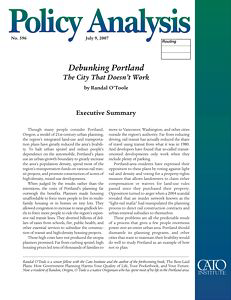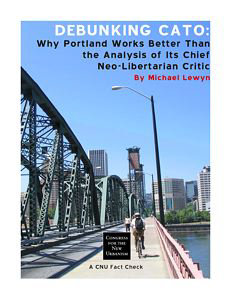No Light Rail in Vancouver!
Light rail costs too much, does too little
Is Portland a Business-Unfriendly Environment?
In 1970, Portland was the headquarters of several Fortune 500 corporations, including
Georgia-Pacific and Louisiana-Pacific. One by one, they all left, claiming that Portland
had a business-unfriendly environment. Only Nike, located in an unincorporated part
of Portland’s suburbs, remains — and only barely, as Nike threatened to move out
when land-use planners tried to force it to turn its office campus into a high-density
residential development.
CNU writer Michael Lewyn ignores this trend and focuses exclusively on my statement
that the high unemployment rates of the early 2000s were, in part, a result of Oregon’s
planning system. His response is to say that other cities had high housing prices
and lower unemployment rates. But housing prices are not the only indicator of a
business-unfriendly environment.
Lewyn ignored my example of Columbia Sportswear, until recently the largest company
still headquartered in Portland. In 2002, it moved out of the city, saying that it
could not find land for its expanded headquarters that was not encumbered by the
city’s highly restrictive transit-oriented zoning.
Is Portland Friendly to Portlanders?
Lewyn points to opinion polls in which Portlanders say they approve of Oregon’s land-use
planning. But opinion polls with vaguely worded questions are not the best available
evidence. My paper pointed to several elections in which Portlanders actually voted
against the region’s transportation and land-use planning system. While this November’s
election may find Portlanders supporting measure 49 (which would repeal parts of
the anti-planning measure 37), they will do so partly because measure 49’s advocates
are claiming that it will still protect people’s property rights.
No matter how coercive it is, Portland is promoting New Urbanist ideas of compact,
mixed-use developments. New Urbanists need to decide: do they support these ideas
because they think people will buy them or because they want to impose them on people
whether those people like them or not? In choosing to side with Portland, Lewyn has
lent his support for forcing people to suffer coercive zoning, high taxes, increased
congestion, and unaffordable homeownership, all to obtain rather trivial gains in
transit ridership and population densities.
My paper argues that the benefits from getting a few more people to ride transit
or live in compact developments are questionable, and even if they are real the costs
of these policies far outweigh the benefits from such tiny gains. Lewyn wants to
believe Portland works, so he is willing to ignore the costs and selectively look
at the data to find benefits that don’t really exist.
If people want to ride transit or live in high-density, mixed-use developments, I
strongly support their choices — provided they are willing to pay the cost. By all
means, let’s junk zoning codes that would prevent developers from satisfying this
market. But don’t replace them with codes that force New Urbanism on people who don’t
want to live that way, or require those people to subsidize those who choose New
Urban lifestyles. Portland doesn’t work because that is what it is trying to do,
without much real success.
Debunking Coercion Part 4
How Friendly Is Portland?
Portland is supposed to be one of the most bicycle-friendly cities in the nation.
But after trying to negotiate the city’s skinny streets (made skinnier by traffic
calming) and getting honked at by the drivers of some of its fat buses, I find it
to be a pretty hostile place for cyclists. Others, too, find Portland an unfriendly
place, particularly businesses trying to grow while negotiating numerous regulations
and restrictions.
Reprinted from The Antiplanner


